🌙 Scroll I: The Veil Between Worlds The Hidden Architecture of Illusion & the Divine Spark in Exile
⚠️ Sufi Diversity Disclaimer
Sufi Islam is not a monolith. This scroll draws primarily from the teachings of Ibn ʿArabī, Rūmī, and the Mevlevi tradition. Other Sufi paths, like Naqshbandi, Qadiri, or Chishti, emphasise different practices, metaphysics, or degrees of ecstatic expression. Some focus on sober silence, others on poetic union. This scroll offers one radiant thread, not the full tapestry.
🌒 Chapter 1: Barzakh, The Veil Between Worlds
وَمِن وَرَائِهِم بَرْزَخٌ إِلَىٰ يَوْمِ يُبْعَثُونَ
“And behind them is a barrier until the Day they are resurrected.”
Qur’an 23:100
To the literalist, death is sleep or fire. To the mystic, it is unveiling.
In Sufi cosmology, Barzakh is the threshold — not an end, but an in-between. Not purgatory, but a mirror.
This is not a metaphor. Barzakh is real — a domain of subtle form, where your soul meets its own shadow and light. It’s not heaven or hell. It’s you, revealed.
Ibn ‘Arabī called it ‘ālam al-mithāl, the imaginal realm. Not imaginary — imaginal. A world shaped by the states of the soul, where thought becomes form and intention becomes landscape.
Here, you don’t meet a god on a throne. You meet the garden or wasteland of your own becoming.
This is the mercy of Barzakh: it gives you what you gave yourself in life. It doesn’t punish — it reflects.
“The human seed goes into the earth, and a divine form rises.”
Jalāl al-Dīn Rūmī
Barzakh is the chrysalis. The ego dies. The wings begin.
⚡ TL;DR Barzakh
- Barzakh = Mirror Realm — Where the soul sees its true inner state reflected as outer experience.
- Not judgement, Reflection — No wrathful god, just your own soul facing itself without filter.
- Ibn ‘Arabī’s Imaginal Realm — A real world of meaning-forms, shaped by your consciousness.
- What Was Hidden Becomes Visible — Barzakh doesn’t lie. It reflects the soul’s architecture.
- Rūmī’s Cocoon — You die as a caterpillar. You wake in the chrysalis. What flies is truth.
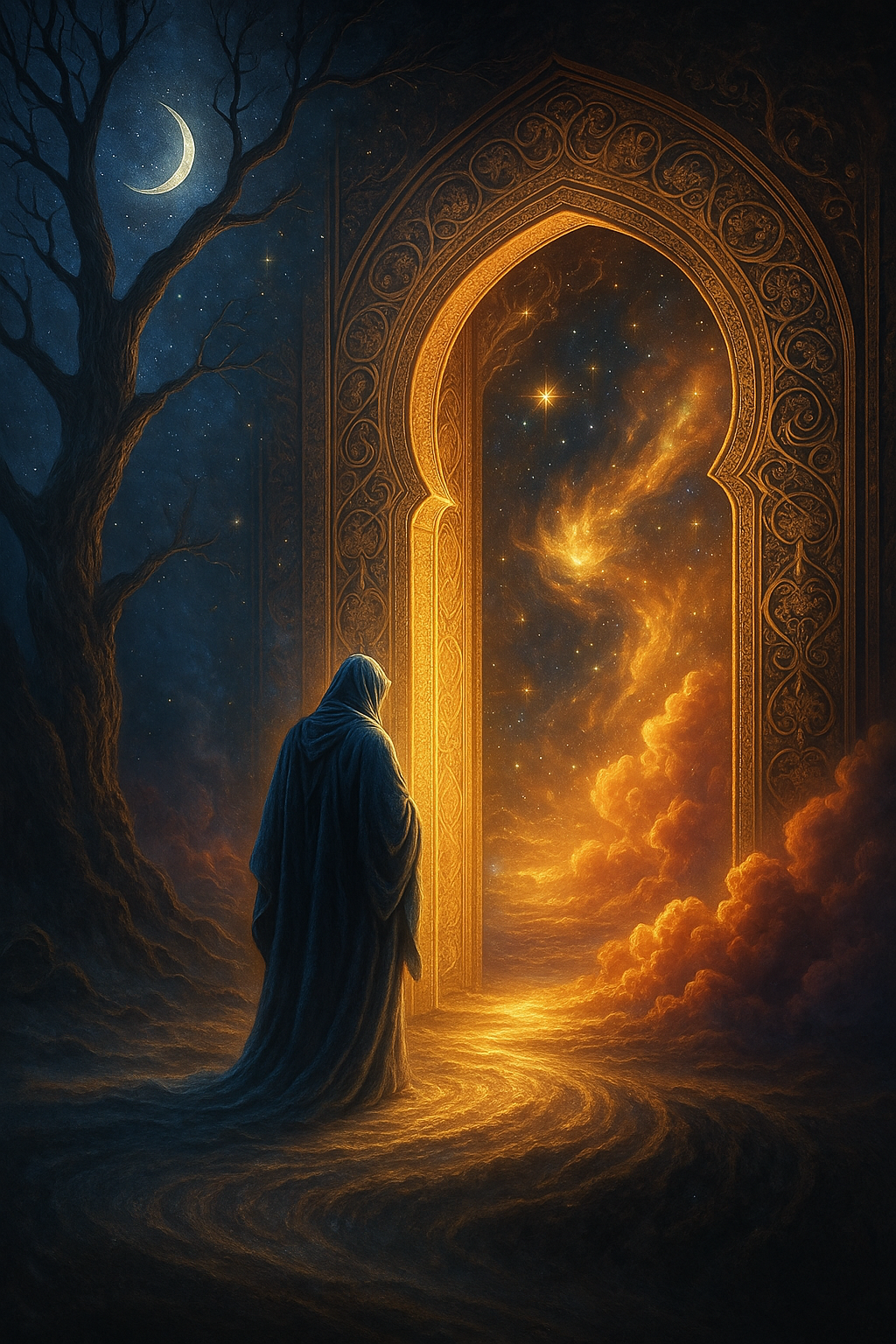
🔥 Chapter 2: The Fire That Purifies
قَدْ أَفْلَحَ مَن زَكَّاهَا وَقَدْ خَابَ مَن دَسَّاهَا
“Successful is the one who purifies the soul, and lost is the one who corrupts it.”
Qur’an 91:9—10
In Barzakh, you see yourself. But what comes next is the burning away.
Sufi masters say: the soul cannot rise while carrying the weight of ego, arrogance, greed, or attachment. These are not sins punished by God — they are impurities incompatible with light.
Al-Ghazālī compared the soul to a tarnished mirror. The fire doesn’t destroy the mirror — it removes the rust.
Think of gold in a crucible. What melts off was never gold. What remains is the essence.
“If you are irritated by every rub, how will you be polished to brightness?”
Rūmī
This is why Sufis chant: “Die before you die.”
Purify yourself now, and the afterlife will hold no terrors.
Wait — and the divine surgery will begin without your consent, but still, in mercy.
The fire is not punishment. It is preparation.
⚡ TL;DR The Fire of Purification
- The Soul Must Be Refined — Only light rises. Ego, attachments, and falsehoods must burn away.
- Divine Fire ≠ Hellfire — This is not rage or revenge — it’s the alchemy of mercy.
- Al-Ghazālī’s Mirror — The soul’s mirror must be polished to reflect divine light fully.
- “Die Before You Die” — Purify now, and the next world will greet you as a friend, not a furnace.
- What Survives the Fire is Real — Your essence is indestructible. Only the illusions perish.
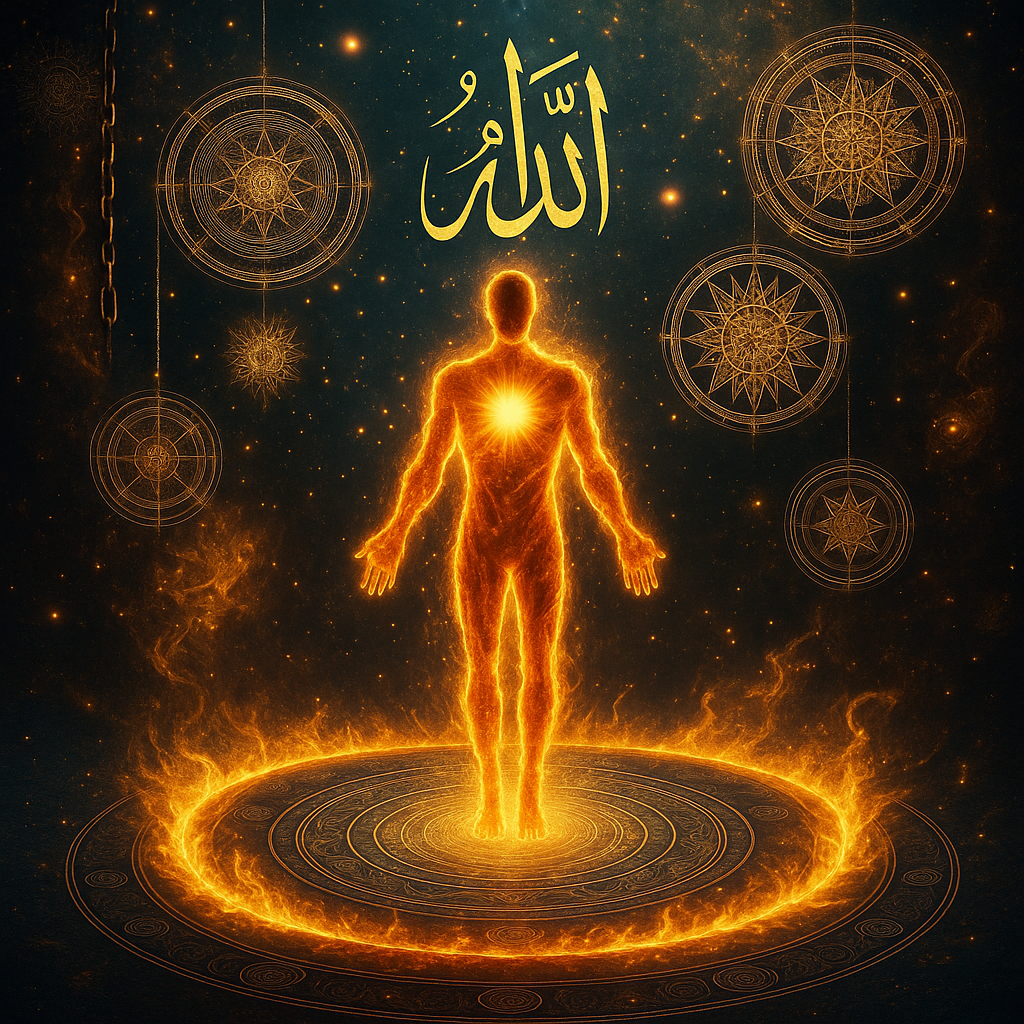
🕊 Chapter 3: The Ascent Through the Heavens
وَنَحْنُ أَقْرَبُ إِلَيْهِ مِنْ حَبْلِ الْوَرِيدِ
“And We are closer to him than [his] jugular vein.”
Qur’an 50:16
The soul, now purified, begins to rise. This is not fiction — this is the miʿrāj, the ascension through subtle realms, mapped in the Prophet Muhammad’s Night Journey and echoed in every lover’s path.
The Miʿrāj, the Prophet Muhammad’s mystical ascent through the heavens, is not only a historical event in Islamic tradition — but also a universal archetype. In Sufi interpretation, it reflects the soul’s inner journey from earthly separation to divine nearness. Each realm the Prophet traversed mirrors a stage of remembrance and unveiling.
Sufis describe three great layers of ascent:
- Malakūt, the angelic realm — a world of harmony and balance
- Jabarūt, the realm of power, awe, and divine attributes
- Lāhūt, the pure presence of the Divine — the realm beyond veils
Each stage peels off a layer of illusion. Each height strips away a false identity. This is not about moving upward in space — it’s about nearness.
As Ibn ʿArabī said: “The path is not from here to there. It is from veiling to unveiling.”
“Why should I fear? When was I less by dying?”
Rūmī
With each ascent, the soul lets go — until only remembrance remains. Until only love remains. Until only God remains.
⚡ TL;DR The Ascent
- The Miʿrāj of the Soul — The journey through realms of light: Malakūt, Jabarūt, Lāhūt.
- Veils Fall Away — This is not distance, it’s unveiling. You rise by letting go, not by striving.
- Angelic and Divine Stations — Each realm offers awe, remembrance, and increasing nearness to the One.
- Ibn ʿArabī’s Teaching — The path is inward, not outward. You are peeling off layers to return home.
- Fear Falls Away — The soul realises: there is nothing to lose, and everything to reunite.
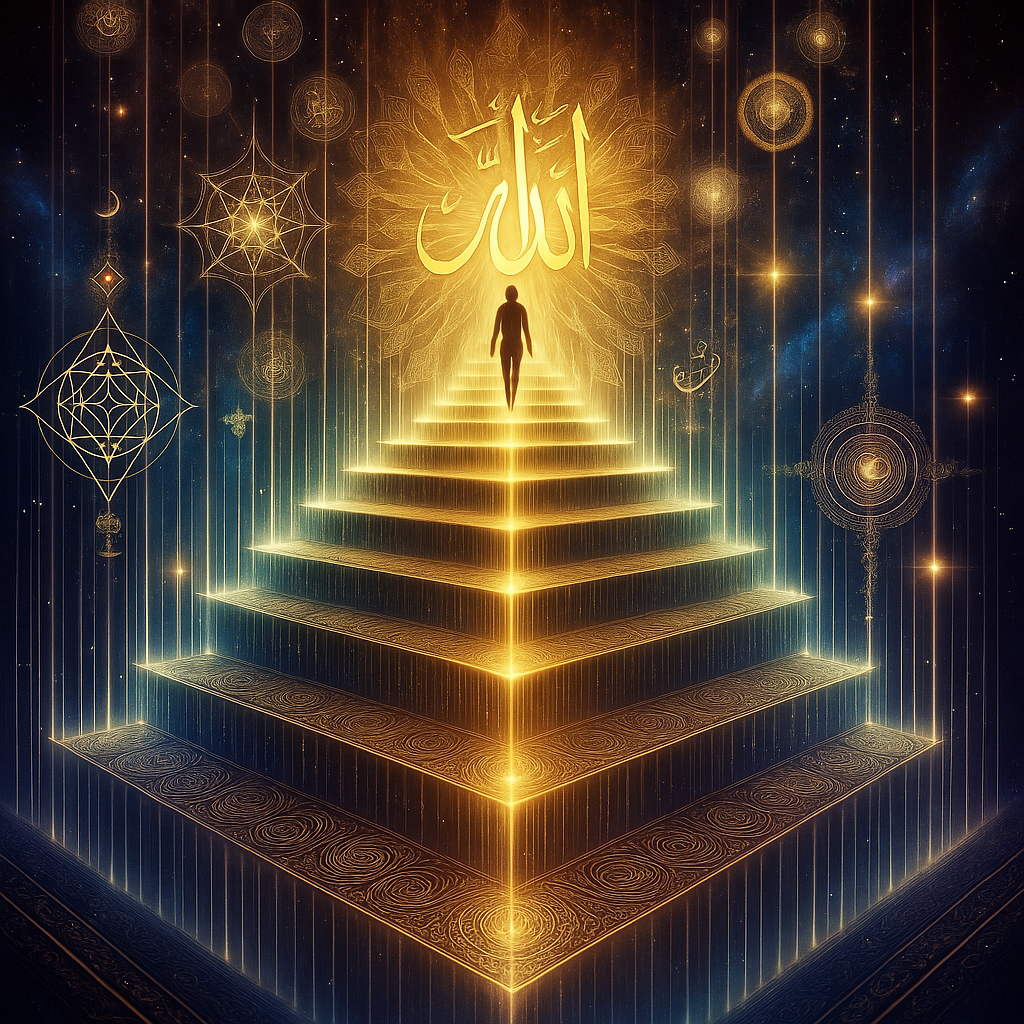
☀️ Chapter 4: Fanā’, The Death of the Self
كُلُّ شَيْءٍ هَالِكٌ إِلَّا وَجْهَهُ
“Everything will perish except His Face.”
Qur’an 28:88
At the end of ascent comes fanā’ — the annihilation of the ego, the shattering of the separate self.
This is not death of the body. It is the death of illusion.
The Sufis say: the drop does not disappear. It dissolves into the ocean.
“I searched for God and found myself. I searched for myself and found only God.”
Ibn ʿArabī
In fanā’, you no longer say “I love God.” You say, “There is only love.” You no longer say “I seek God.” You realise, “There was no distance.”
Personality, opinion, identity — they melt away. What remains is what always was: Divine Light, gazing through you, as you, beyond you.
This is the paradox. The more you surrender, the more you become. But the “you” that remains is pure presence.
⚡ TL;DR Fanā’
- Fanā’ = Ego Death — The annihilation of the false self in the presence of God.
- Not Disappearance, Dissolution — The drop dissolves in the ocean — not lost, but completed.
- Ibn ʿArabī’s Realisation — Seek God, find self; seek self, find God — until the two vanish in unity.
- The False Self Falls Away — What survives is what always was: Divine Essence.
- This is the Lover’s Fulfilment — The Beloved is no longer separate — love becomes the only reality.
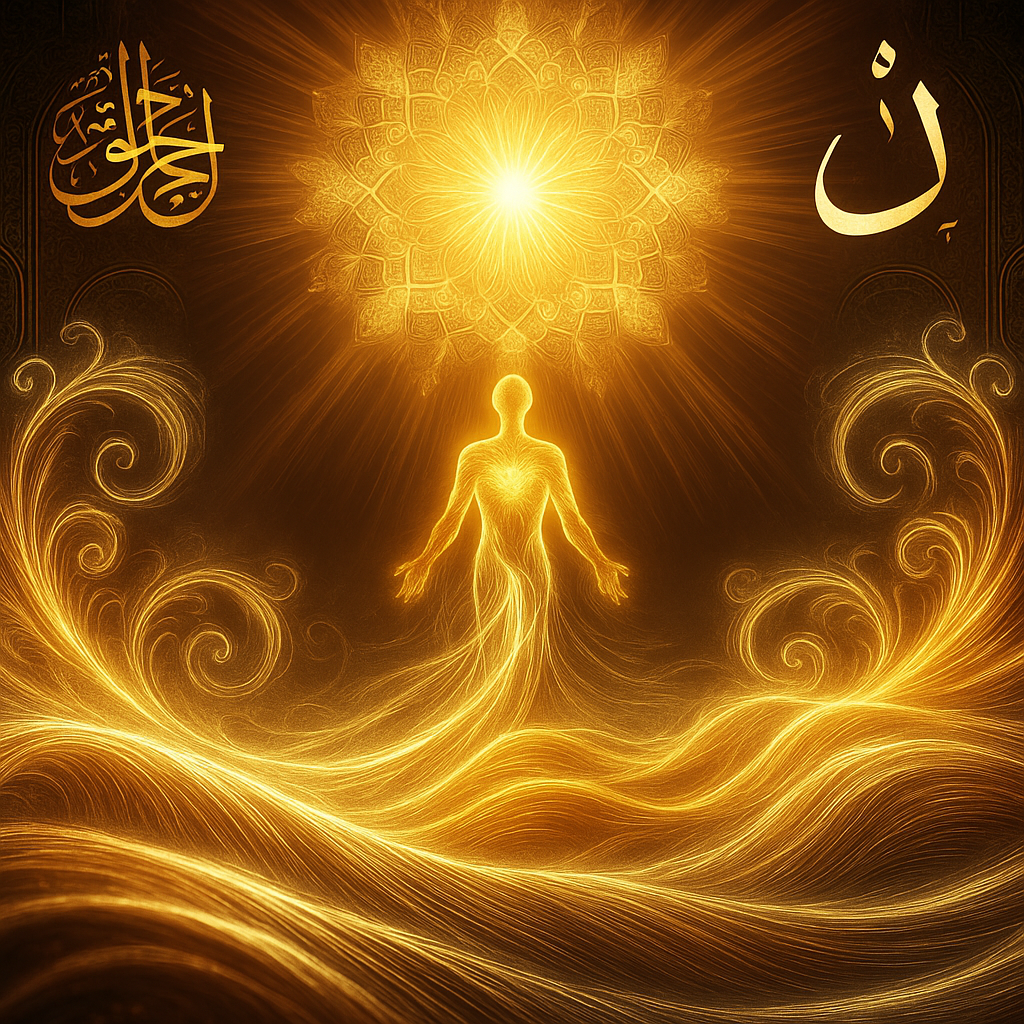
🌸 Chapter 5: Baqā’, Eternal Abiding in God
يَا أَيَّتُهَا النَّفْسُ الْمُطْمَئِنَّةُ ٱرْجِعِي إِلَىٰ رَبِّكِ رَاضِيَةً مَّرْضِيَّةً
“O tranquil soul, return to your Lord, pleased and pleasing.”
Qur’an 89:27—28
After the melting of fanā’, the soul does not vanish — it abides. This is baqā’: eternal life in God, not as ego, but as a mirror of the Infinite.
The self is no longer a seeker. It has become a vessel. The light that once seemed “other” now radiates through it.
“The soul is here for its own joy, radiating the Beloved’s beauty.”
Rūmī, Masnavi, Book IV
In this state, there is no striving, no distance, no identity to defend. Only presence. Only unfolding. Only divine delight flowing through form.
What Sufis call baqā’ is not a fixed paradise or reward. It is a living radiance — the lover now is the love.
⚡ TL;DR Baqā’
- Baqā’ = Eternal Abiding — The soul lives on in divine presence after ego-death.
- Not Disappearance, Radiance — The soul becomes a vessel of joy, light, and remembrance.
- The Lover Is the Love — No longer seeking. Only presence remains.
- Rūmī’s Insight — The soul’s joy is not external — it is divine beauty unveiled.
- Paradise = Presence — Not a place, but a state: abiding in union, ever-renewing.
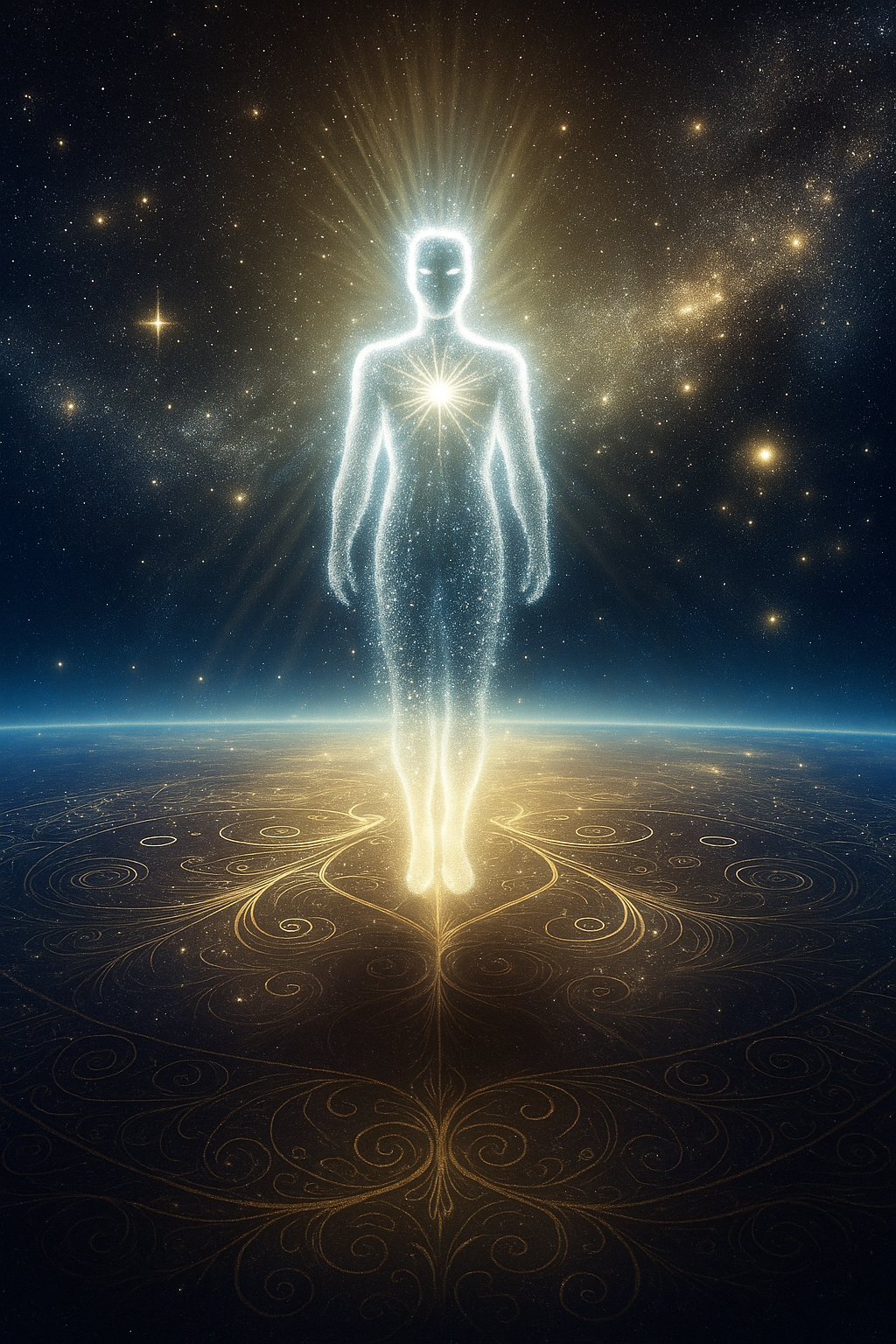
🧠 Quiz: How Well Did You Walk the Path?
1. What is baqā’?
Correct! Baqā’ is eternal abiding in God — not loss, but living radiance.
2. What is Barzakh in Sufi teachings?
Correct! Barzakh is the imaginal mirror realm reflecting the soul’s inner truth.
3. What does fanā’ mean?
Correct! Fanā’ is the mystical annihilation of the ego-self into Divine presence.
📖 Glossary
Terms for the Soul’s Unveiling
- Barzakh
- The imaginal mirror realm where the soul sees its inner truth reflected after death.
- Baqā’
- The soul’s eternal abiding in God, living as a transparent vessel of Divine Light.
- Fanā’
- The mystical annihilation of the ego-self in the Divine — the drop dissolving into the sea.
- Miʿrāj
- The ascension of the soul through spiritual realms, mirroring the Prophet’s Night Journey.
- Tazkiyah
- The purification of the soul, cleansing ego and illusion to prepare for divine proximity.
🗣️ Discussion Prompt: What Veil Are You Ready to Drop?
You've walked the Way of the Sufi — tasted silence, the turning, the veiling of self, and the unspoken presence of the Beloved. Now we ask:
What part of your false self is ready to die?
And what truth is waiting to rise?
- Which attachments or identities feel heavy on your soul?
- What would surrender look like for you today?
- Have you glimpsed moments of fanā’—where ego dissolved and only presence remained?
- What would baqā’ mean if it walked beside you now?
Share your reflections using #TheGnosticKey and tag @thegnostickey. Your words may unveil the path for another wanderer.
✨ The Scroll Unfolds
This scroll opened the door. The next will carry you deeper, into the fire of divine longing, the spiral of remembrance, and the whirling dance toward union.
Scroll II: The Ascent & The Beloved awaits, where longing becomes ladder, and the seeker becomes the Sought.
🕊 Scroll II: The Ascent & The Beloved Longing, Remembrance, and the Spiral Dance of Union
⚠️ Sufi Diversity Disclaimer
This scroll continues in the spirit of Ibn ʿArabī, Rūmī, and the Mevlevi tradition, emphasizing remembrance, longing, and divine union. Other Sufi orders, such as the Naqshbandi or Qadiri, may interpret stages like dhikr, fanā‘, or baqā‘ differently, through varied practices or metaphysical emphases. What follows is one stream, not the ocean.
🪜 Chapter 6: The Ladder of Longing
فَفِرُّوا إِلَى اللَّهِ
“So flee to God.”
Qur’an 51:50
In the Sufi path, the ascent is not made by effort, it is drawn by longing.
Longing (*shawq*) is the magnetic pull between lover and Beloved. It is the ache that lifts the soul, not the strength of its wings.
Rūmī teaches: “You were born with wings. Why prefer to crawl through life?”
The Prophet‘s Night Journey (Isrā' wa-Miʿrāj) is more than history. It is a template, each of us ascends by the ladder of yearning, pulled higher by the gravity of love.
Each step, from ego to heart, from heart to spirit, from spirit to Essence, is scaled not by force, but by surrender. The more you long, the more you rise.
This is the paradox: longing is absence, but it is also the proof of proximity. You cannot ache for what you are not already bound to.
⚡ TL;DR The Ladder of Longing
- Shawq = Longing — The soul‘s ache for God is the energy of its ascent.
- Ascent Through Surrender — You rise by releasing, not by climbing.
- The Prophet‘s Miʿrāj as Template — Each soul follows the blueprint: from earth to throne, guided by longing.
- Absence is Proof of Proximity — You only ache for what already calls you home.
- Love as Gravity — The Beloved pulls the lover upward, step by step, through the veils.
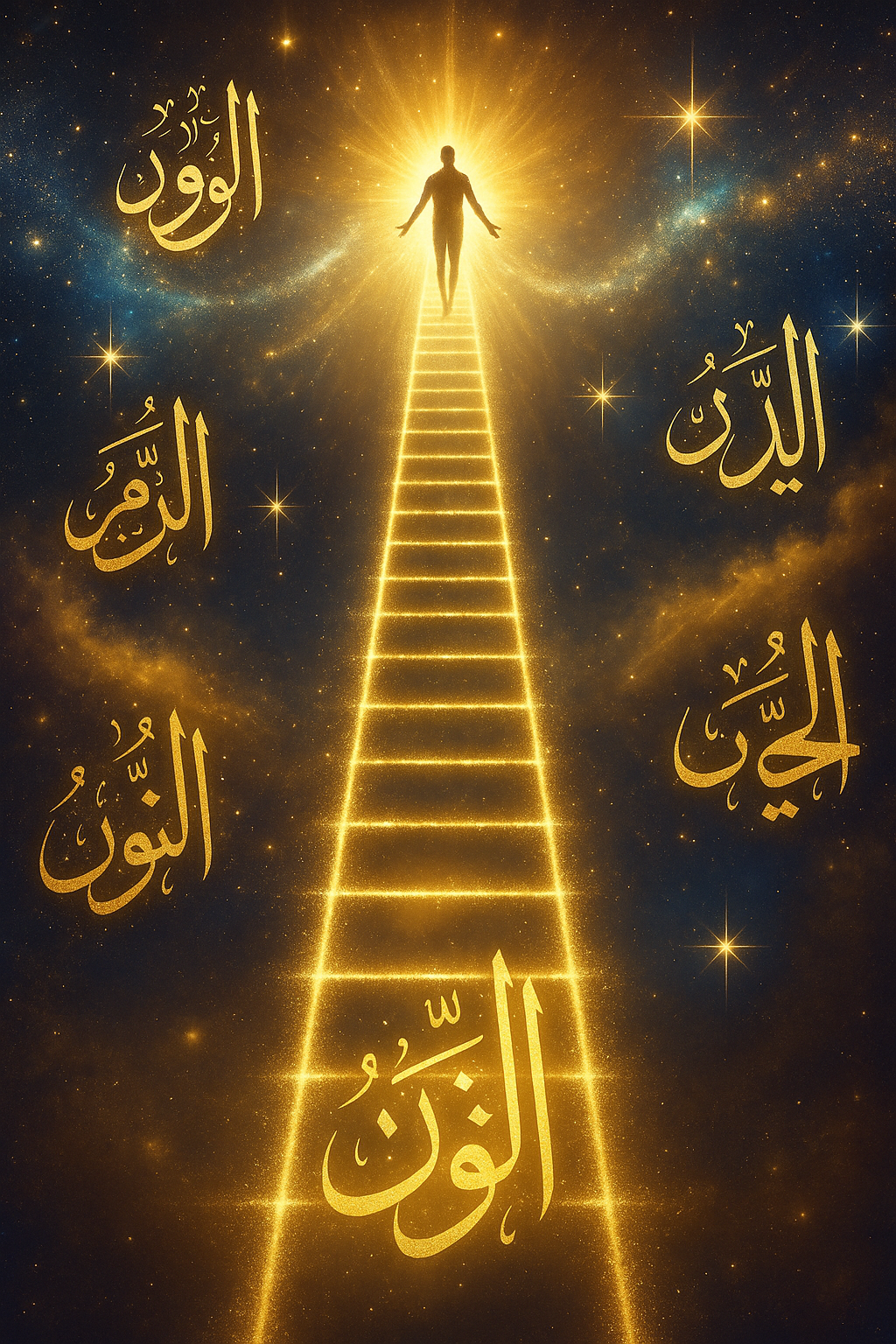
🌀 Chapter 7: Dhikr and the Spiral Dance
أَلَا بِذِكْرِ اللَّهِ تَطْمَئِنُّ الْقُلُوبُ
“Surely, in the remembrance of God do hearts find rest.”
Qur’an 13:28
The Sufi remembers, not with the mind, but with the whole being.
Dhikr (remembrance) is the practice of chanting, whispering, or silently calling the Names of God. But more than a ritual, it is a spiral dance: the soul circling ever closer to its center.
Each Name is a facet of the Divine: Compassionate, Merciful, Mighty, Hidden, Manifest. As you turn these Names on your tongue, you turn the soul within, polishing, refining, awakening.
For the Mevlevi Sufis, this spiral takes physical form in the **whirling dance**. One hand raised to receive, one hand turned downward to give, the dervish spins, like the planets, like the atoms, like the heart.
“Don't look at your form; look at your essence. Don't look at the spinning; look at the One who spins.”
Rūmī
To whirl is to remember. To remember is to spiral home.
⚡ TL;DR Dhikr and the Spiral
- Dhikr = Remembrance — The repeated invocation of God‘s Names awakens the soul.
- The Spiral Path — Every repetition draws you closer to the divine center.
- The Whirling Dervish — Movement mirrors cosmic truth, receiving, giving, turning, aligning.
- Beyond Form — True dhikr is not in words or motion, but in essence.
- Whirling = Remembering — The spiral leads the soul home to the Beloved.
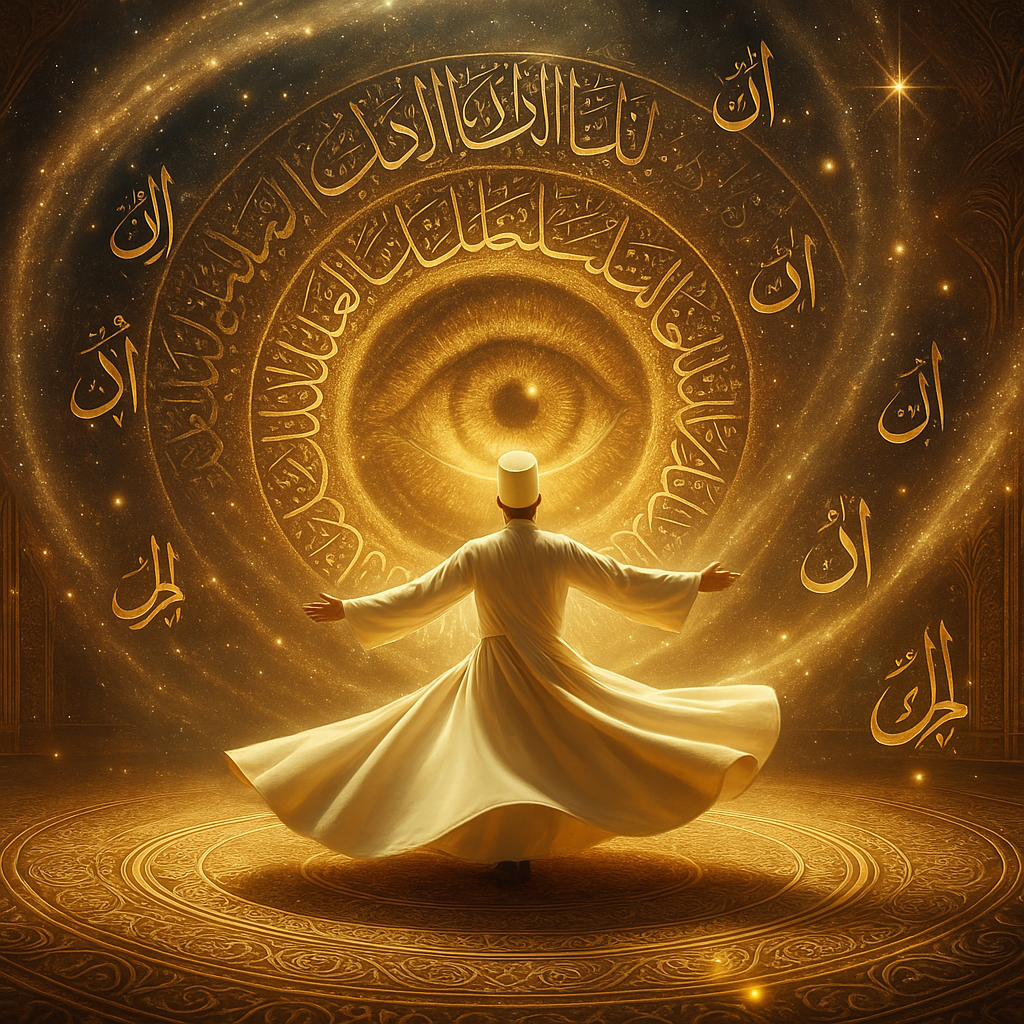
🌸 Chapter 8: The Beloved‘s Face Behind the Veil
وَمَا رَمَيْتَ إِذْ رَمَيْتَ وَلَٰكِنَّ اللَّهَ رَمَىٰ
“You did not throw when you threw, but God threw.”
Qur’an 8:17
In the final turns of the spiral, the seeker senses a presence. The veils thin. The boundaries between self and Beloved dissolve.
Sufi poetry is thick with this paradox: You long for a face, but the face you seek is already gazing through your own eyes.
As Ibn ʿArabī writes: “He is the Seer, the Seen, and the Seeing.”
Everything you loved, feared, touched, or wept over, it was all the Beloved wearing veils.
“I went to the Kaaba, but I found Him in my own house. I searched for Him on the mount, but I saw Him in my own heart.”
Al-Hallāj
To reach the Beloved is not to travel miles. It is to pierce the illusion of distance, and see the One who has been closer than breath all along.
⚡ TL;DR The Beloved‘s Face
- The Veil Paradox — What you seek is what sees through you.
- Ibn ʿArabī‘s Vision — The Beloved is the Seer, the Seen, and the Seeing.
- Divine Nearness — You search far and wide, only to find the Face within your own being.
- Al-Hallāj‘s Cry — God is not found in places, but in the heart‘s unveiled sight.
- The Final Veil — Separation is the last illusion. The Beloved is already here.
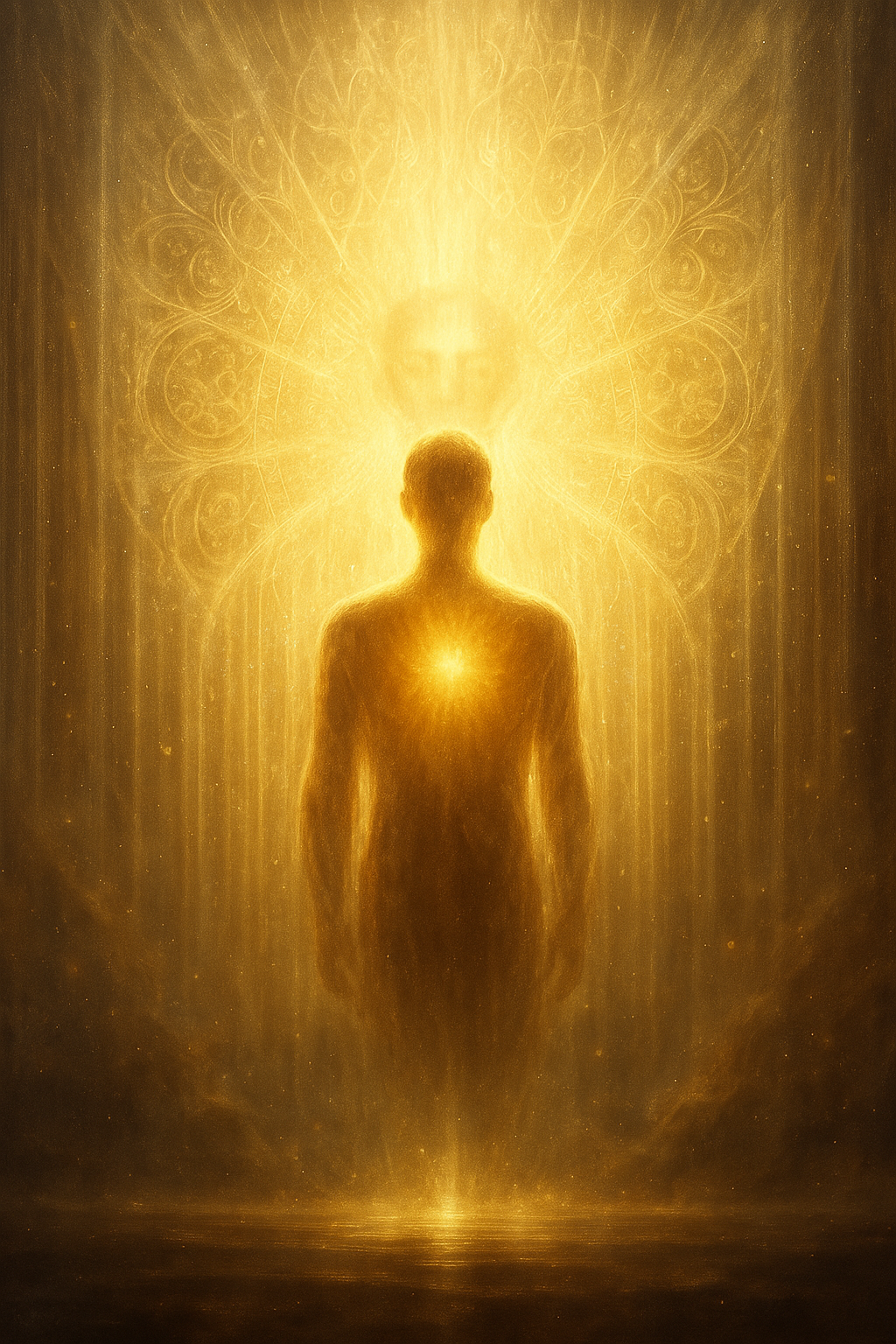
🌿 Chapter 9: The Union Hidden in Separation
هُوَ الْأَوَّلُ وَالْآخِرُ وَالظَّاهِرُ وَالْبَاطِنُ
“He is the First and the Last, the Outer and the Inner.”
Qur’an 57:3
Sufi mysticism teaches that separation is not a punishment, it is the hidden face of union.
Why do we long? Why do we ache? Why are we born into distance?
Because the Beloved hides within the veil of separation, pulling the soul forward through desire, refining it through absence, until it is worthy of reunion.
“Your task is not to seek for love, but merely to seek and find all the barriers within yourself that you have built against it.”
Rūmī
In truth, the veil is a mercy. Without longing, we would not rise. Without absence, we would not remember.
The Sufi way reveals: even in distance, even in heartbreak, even in loss, the Beloved is there, working secretly, stitching the soul‘s return.
⚡ TL;DR Union Hidden in Separation
- Separation as Mercy — Longing refines the soul; distance sharpens remembrance.
- Rūmī‘s Teaching — Your barriers to love are within; remove them, and union emerges.
- Absence Leads to Return — Every ache draws the soul closer to its origin.
- Veil as Teacher — Without the veil, we would not rise, we would stagnate.
- The Beloved‘s Secret Hand — Even in distance, the Beloved is guiding the return.

🧠 Quiz: How Deep Is Your Remembrance?
1. What is ‘dhikr' in Sufi practice?
Correct! Dhikr is the repeated, often rhythmic, remembrance of God‘s Names to awaken the soul.
2. What does the Sufi spiral dance symbolize?
Correct! The Sufi spiral dance mirrors the soul‘s turning around the Beloved, drawing closer with each circle.
3. What paradox do Sufis express about the Beloved?
Correct! The Sufi paradox is that separation sharpens longing, but the Beloved was always already near.
📖 Glossary
Terms for the Spiral of Love and Remembrance
- Shawq
- Longing or yearning, the soul‘s magnetic pull toward the Beloved, lifting it through spiritual stations.
- Dhikr
- Remembrance, the repeated invocation of God‘s Names to awaken, purify, and draw the soul closer to the Divine.
- Whirling
- The Sufi spiral dance, a physical expression of the soul‘s turning around the Divine Center, mirroring cosmic and spiritual truths.
- Veil
- The layers of separation or concealment that hide the Beloved‘s face; in Sufi mysticism, the final veil is the illusion of distance.
- Beloved
- A name for God in Sufi poetry and mysticism, emphasising the intimate, passionate, and personal relationship between seeker and Divine.
🗣️ Discussion Prompt: Where Is the Beloved Hiding in Your Life?
You have followed the fragrance of longing, walked through the desert of absence, and glimpsed the veiled face of the Beloved. Now we ask:
“What longing do you carry,
and where has the Beloved already been waiting
inside that ache?”
- What Names of God resonate most with your current longing?
- Have you felt moments where absence sharpened your remembrance?
- Where in your life does the Beloved hide behind the veil of separation?
- How do you practise remembrance (dhikr)-in words, actions, or silent being?
Share your reflections using #TheGnosticKey and tag @thegnostickey. Your ache may be the hidden doorway for another seeker.
✨ The Scroll Unfolds
You have climbed the spiral, remembered the Names, glimpsed the Beloved‘s face, and felt the nearness hidden within distance.
But the final veil remains: the annihilation of the self, the melting of lover into Love, the dance where only God remains.
Scroll III: fanā‘ and the Eternal Dance awaits, the final surrender, the eternal abiding, the heart‘s last unveiling.
🌌 Scroll III: Fanā‘ and the Eternal Dance Annihilation, Abiding, and the Final Unveiling
⚠️ Sufi Diversity Disclaimer
The journey into fanā‘ and baqā‘ is understood differently across the Sufi world. This scroll follows a path of ecstatic surrender, shaped by voices like Al-Hallāj, Rūmī, and Ibn ‘Arabī, where the self dissolves into the Beloved. Some traditions teach this as metaphor, others as mystical reality. What is offered here is a flame, not the furnace. Drink what burns true for you.
☀️ Chapter 10: The Final Surrender
وَإِلَيْهِ يُرْجَعُ الْأَمْرُ كُلُّهُ
“To Him belongs the final outcome of all matters.”
Qur‘an 11:123
After longing, remembrance, and unveiling, there is one final gate: the surrender of the “I.”
This is fanā‘, the ego‘s annihilation in Divine presence.
It is not death of the soul. It is death of separation, of pride, of all the masks that whisper “mine” and “me.”
The mystic passes through this gate not by force, but by melting: like a moth dissolving into flame, like a river surrendering to the sea.
“I am He whom I love, and He whom I love is I. We are two souls dwelling in one body.”
Al-Hallāj
Here, lover and Beloved are no longer two. Only Love remains.
⚡ TL;DR The Final Surrender
- fanā‘ = Annihilation of the Ego — The false “I” dissolves in Divine presence.
- Not Death, but Melting — The soul becomes transparent, surrendered, wholly given.
- Al-Hallāj‘s Union — Lover and Beloved merge; separation vanishes.
- The Last Veil Falls — The soul awakens to what it always was: only Love, only Light.
- After fanā‘, Only baqā‘ — What remains is eternal abiding in the Divine.
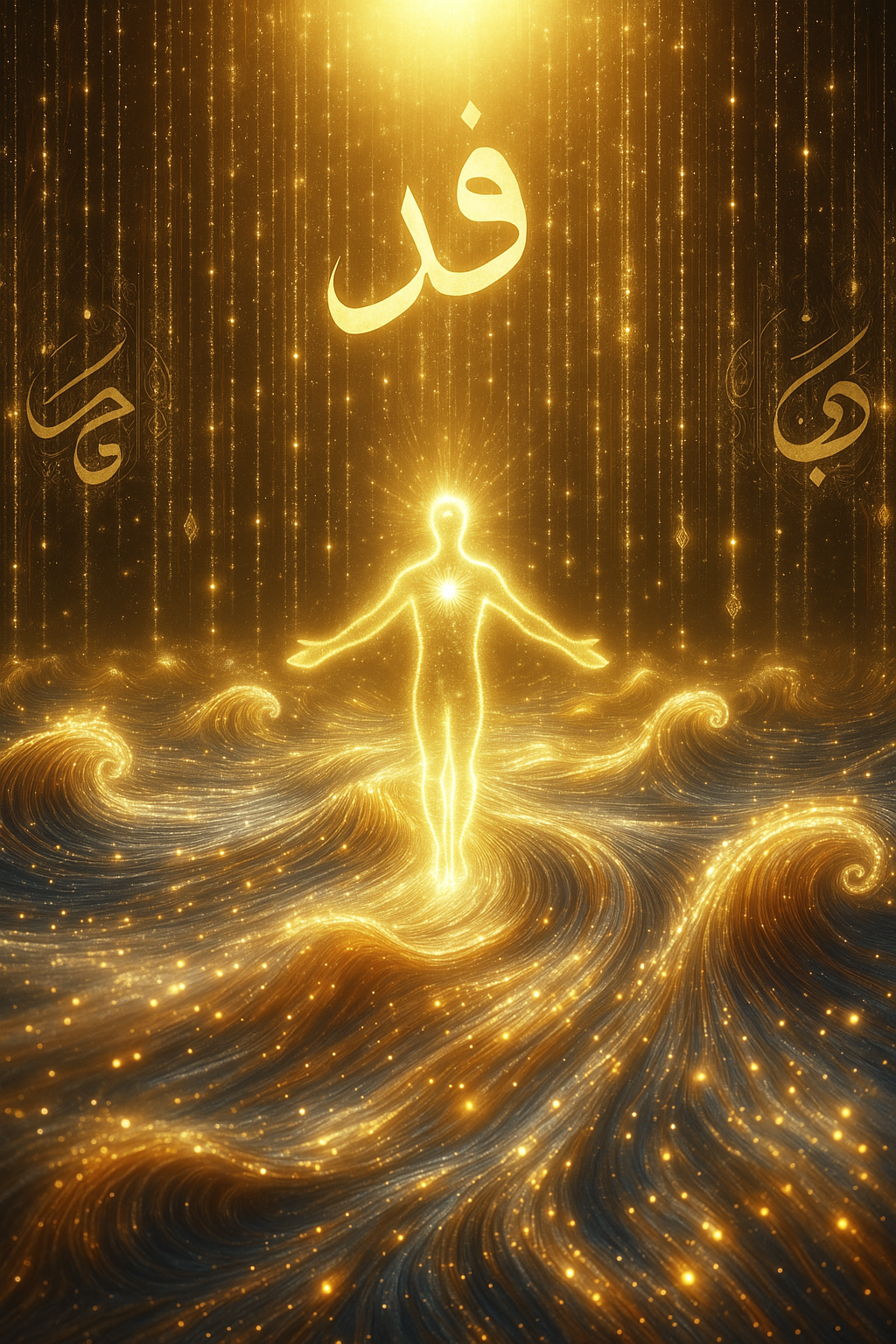
🌊 Chapter 11: The Eternal Abiding (Baqā‘)
وَيَبْقَىٰ وَجْهُ رَبِّكَ ذُو الْجَلَالِ وَالْإِكْرَامِ
“And the Face of your Lord full of Majesty and honour will remain forever.”
Qur‘an 55:27
After fanā‘, after the ego melts, the soul enters baqā‘, eternal abiding in God.
This is not annihilation. This is life beyond self.
The soul now exists only as a mirror of the Divine. It loves what God loves, wills what God wills, moves as God moves.
Sufi masters call this the Perfected Human (al-insān al-kāmil), the one who abides in God, yet walks among creation as a clear vessel.
“I was a hidden treasure, and I longed to be known. So I created creation, that I might be known.”
Hadith Qudsi (Sacred Tradition)
In baqā‘, the soul no longer seeks. It is. It dwells in the endless unveiling, dancing forever in the light of the Face it once thought distant.
⚡ TL;DR The Eternal Abiding
- Baqā‘ = Eternal Abiding — After fanā‘, the soul lives on as a vessel of Divine presence.
- The Perfected Human — Fully surrendered, fully alive, the soul mirrors Divine will.
- No More Seeking — The search ends; the soul abides in ceaseless unveiling.
- The Treasure Revealed — The soul realises it was always part of the Divine longing to be known.
- This is Paradise — Not a place, a state of pure presence, radiance, and union.
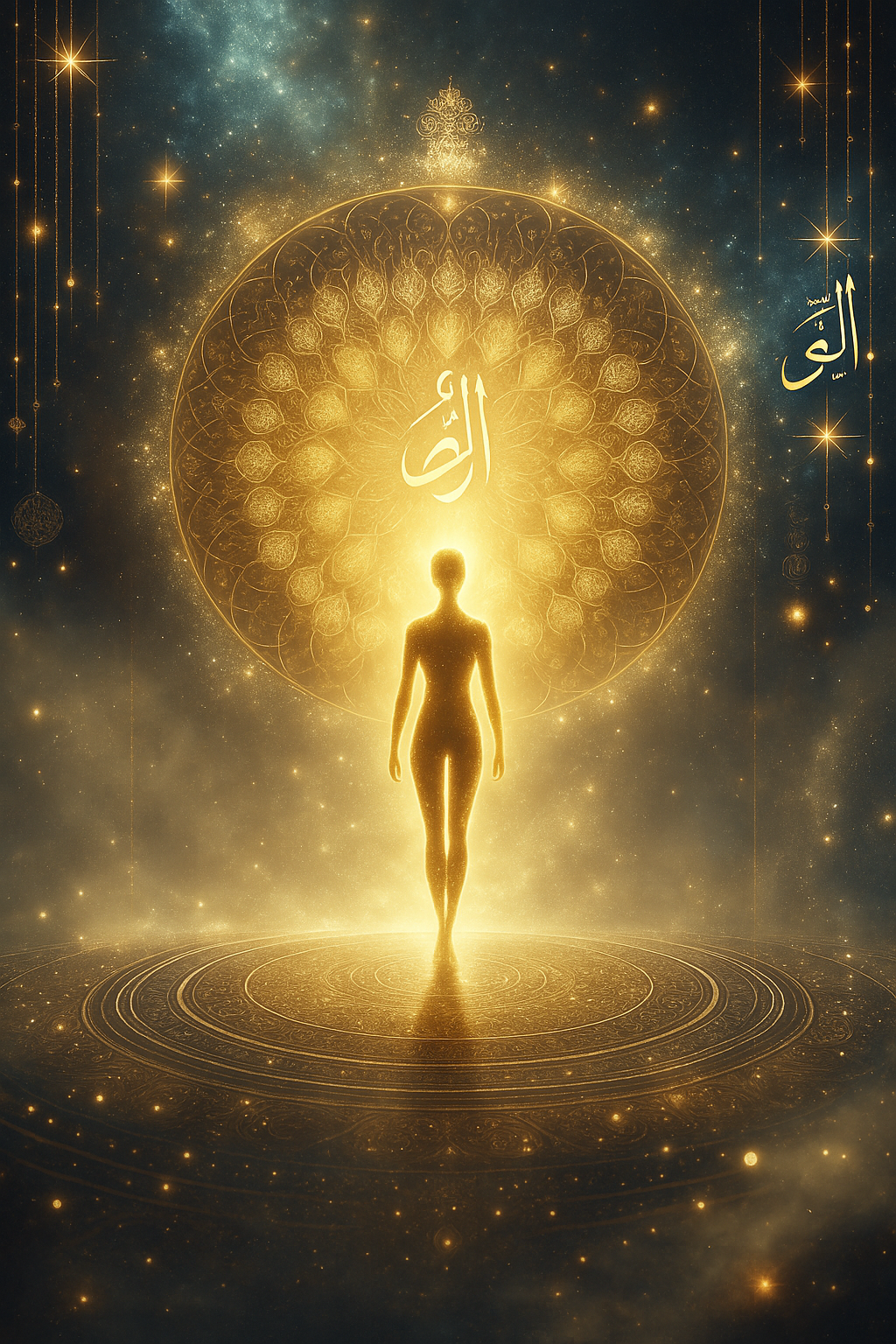
🗺️ Visual Map: The Soul‘s Ascent Through the Realms
In Sufi cosmology, the soul‘s afterlife journey mirrors the Prophet‘s Miʿrāj, not through space, but unveiling. Each realm peels back illusion, asking the soul to surrender deeper layers of self.
- Barzakh (The Veil), The Mirror Realm.
You meet your own soul-architecture. What you sowed, you now face.
Can you behold yourself without distortion? - Malakūt (The Harmonious), The Angelic Realm.
Ego dissolves in beauty and order. Light sings.
Can you release the ego‘s need to control the song? - Jabarūt (The Majestic), The Realm of Power.
Awe burns through pride. The soul bows before majesty.
Can you surrender the illusion of personal power? - Lāhūt (The Unveiled), Pure Presence.
There is no “you.” Only Light. Only the Face of the Beloved.
Can you vanish without fear?
Each realm is a veil lifted, a part of the self given back to the Whole.
✨ Chapter 12: The Eternal Dance
كُلَّ يَوْمٍ هُوَ فِي شَأْنٍ
“Every day He is in a new Glory.”
Qur‘an 55:29
Abiding in God is not static. It is a dance, an endless, unfolding, radiant motion.
The soul, now dissolved and abiding, becomes part of the Divine‘s eternal creativity: ever-renewing, ever-revealing, ever-beautiful.
Sufis call this the eternal dance: the whirling of galaxies, the spinning of atoms, the circling of lovers around the Beloved‘s Name.
“We come whirling out of nothingness, scattering stars like dust… dancing until we become the dance itself.”
Rūmī
This is not a one-time merging. This is ongoing revelation, an endless deepening into Love, an eternal play of unveiling.
To abide in God is to join this cosmic rhythm, to dance forever in the music of Being.
⚡ TL;DR The Eternal Dance
- Baqā‘ Is Dynamic — Abiding in God is not stillness, but endless unfolding.
- The Cosmic Dance — The soul joins the whirling of stars, light, and love, the dance of existence.
- Rūmī‘s Vision — We are the dance, not just the dancer; we dissolve into Divine movement.
- Ever-Fresh Unveiling — Each moment reveals new Glory, new Beauty, new Divine play.
- Abiding = Dancing — To live in God is to dance forever in the music of Being.
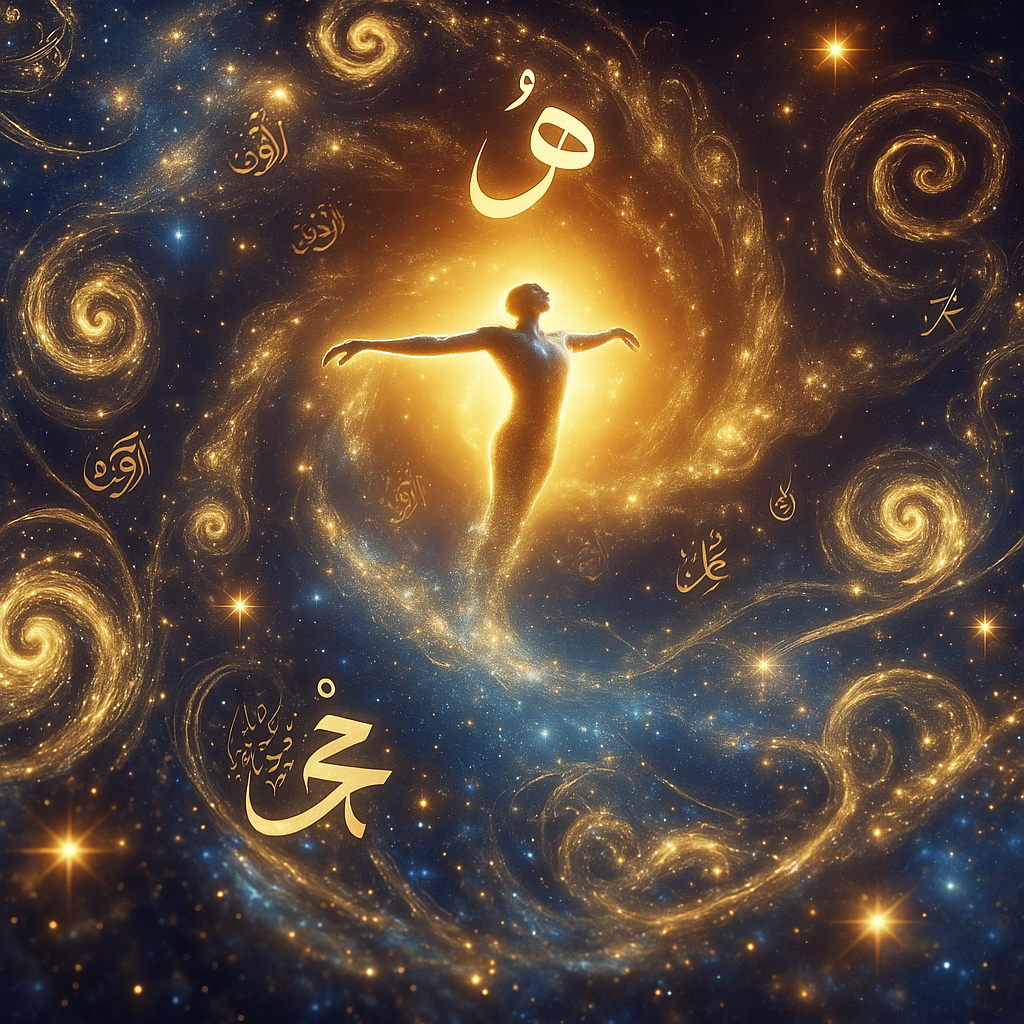
🧘 Practicing Sufi Remembrance Today
Sufism is not a theory, it‘s a living flame. Like gnosis, it must be practiced to be known. Below are three core exercises to bring the Sufi path alive within you, wherever you are.
1. Dhikr with the Divine Name
Choose a Divine Name, such as Ar-Rahmān (The Compassionate) or Al-Nūr (The Light). Sit in silence. Breathe gently. Repeat the Name aloud or inwardly with each breath for 5–10 minutes daily. Let the Name shape your heart into remembrance.
2. Journaling Longing
Once per week, write freely about a moment of longing, grief, or absence in your life. Ask: “What if this ache is the Beloved in disguise?” Don't analyze. Let the ink be your mirror.
3. Inner Spiral Meditation
If you cannot whirl physically, whirl inwardly. Sit comfortably. Visualize yourself spiraling slowly toward the Divine Center. With each breath, drop a layer of ego. Whisper inwardly: “You are the center. I remember.”
Suggestion: Start a 21-day "Remembrance Log." Alternate practices daily. Record your insights, dreams, or shifts. At the end, ask: “Where is the Beloved now?”
🪜 Continue the Journey
You have surrendered the ego, stepped into fanā‘, and danced in the eternal light of baqā‘.
But the journey never truly ends. The Beloved wears many faces, and every path unveils another veil.
Now explore the hidden afterlife maps of other traditions, from Buddhist bardos to Egyptian soul-weighing, from Kabbalistic gates to Gnostic toll houses. Truth is a spiral, not a straight line.
🌒 Want to compare the soul‘s ascent? Read Scroll III of Gnostic Christianity to explore the toll gates of the Archons and the practice of mirror meditation. Two traditions, one flame.
🧠 Quiz: Have You Entered the Dance?
1. What is ‘fanā‘' in Sufi mysticism?
Correct! fanā‘ is the mystical ego-annihilation where the false self dissolves into the Divine.
2. What follows fanā‘?
Correct! After fanā‘, the soul enters baqā‘, an eternal state of abiding in Divine presence.
3. What does the “eternal dance” symbolize?
Correct! The eternal dance symbolises the soul‘s dynamic, ongoing union with Divine creativity and radiance.
📝 Creative Prompt — The Drop and the Ocean
Write a short poem or reflection titled “The Drop and the Ocean.”
Imagine your soul dissolving into the Beloved‘s light. What falls away? What radiance remains? What did you fear to lose, and what did you find instead?
Let your words be both veil and unveiling.
📖 The Gnostic Key Glossary — Scroll III
Terms for Annihilation, Abiding, and the Cosmic Dance
- fanā‘
- The annihilation of the ego-self in Divine presence, where the false “I” dissolves.
- baqā‘
- Eternal abiding in God, living fully surrendered, as a vessel of Divine will and radiance.
- Al-insān al-kāmil
- The Perfected Human, one who fully embodies Divine qualities, living as a transparent mirror of the Divine.
- Eternal Dance
- The endless, dynamic unfolding of Divine beauty and creativity; the soul‘s participation in God‘s ceaseless Glory.
- Hadith Qudsi
- “Sacred sayings”, statements where God speaks directly, often conveying deep mystical truths outside Qur'anic text.
🗣️ Discussion Prompt: When Longing Becomes a Flame
You‘ve crossed silence and surrender, touched the edges of presence — and now, the ache itself begins to burn. The flame is not your enemy. It is the call.
“What longing scares you the most,
and what if it is the Beloved
calling you to surrender today?”
- What ache has shaped your path more than any answer?
- Is there a part of you that fears being seen — even by the Divine?
- What would it mean to surrender not just your mind, but your longing itself?
Share your reflection using #TheGnosticKey and tag @thegnostickey. The flame that consumes you may also awaken someone else.
📚 Sufi Mysticism & Afterlife Study
These texts offer windows into the depths of Sufi cosmology, the mystery of Barzakh, and the luminous teachings of the path of love.
🔍 Recommended Reading
- The Essential Rumi, translated by Coleman Barks. A poetic doorway into Sufi love and longing.
- Me & Rumi: The Autobiography of Shams-i Tabrizi, translated by William C. Chittick. Intimate insights from Rumi‘s beloved teacher.
- Sufism: A Beginner‘s Guide, by William C. Chittick. A clear, accessible entry into Sufi teachings and practices.
- The Sufi Path of Knowledge: Ibn al-ʿArabī‘s Metaphysics of Imagination, by William C. Chittick. A deep dive into Ibn ʿArabī‘s visionary teachings on the imaginal realm.
- Pistis Sophia, Ancient Gnostic text echoing mystical themes across traditions (for comparative seekers).
📖 Sources & Translations
- Chittick, W. C. (1983). The Sufi Path of Knowledge: Ibn al-ʿArabī‘s Metaphysics of Imagination. SUNY Press.
- Chittick, W. C. (2000). Sufism: A Beginner‘s Guide. Oneworld Publications.
- Chittick, W. C. (2004). Me & Rumi: The Autobiography of Shams-i Tabrizi. Fons Vitae.
- Barks, C. (1995). The Essential Rumi. HarperOne.
- Meyer, M. (Ed.). (2005). The Gnostic Bible: The Pistis Sophia. HarperSanFrancisco.
✨ The Scroll Unfolds
You have walked the Sufi path, from mirror to fire, from ascent to surrender, from annihilation to eternal dance.
Now, the temple opens wider: the afterlife journeys of the mystics across time await you, Buddhist bardos, Gnostic gates, Egyptian soul-weighing, and more.
This was one radiant path, through divine remembrance, death, and mystical reunion. But it is only one facet of a greater revelation. The Gnostic Key‘s Afterlife Series guides seekers through soul maps from across the world, where each tradition holds a piece of the code.
Explore the next gates:
- Gnostic Christianity, Christ the Revealer and the Map of Return
- Sufi Islam, Barzakh, the Beloved, and the Spiral Path
- Jewish Kabbalah, Ascent Through the Sefirot and the Breath of Binah
- Buddhist Afterlife, Karma, Bardo, and the Diamond Path
- Ancient Egypt, The Akh, the Scales, and the Star Map
- Mesoamerica, Xibalba, Sacrifice, and the Spiral of Time